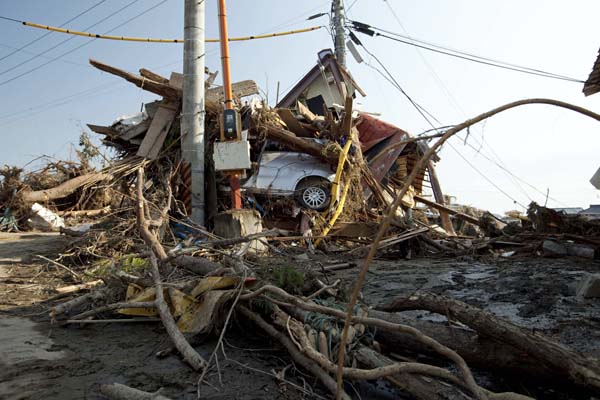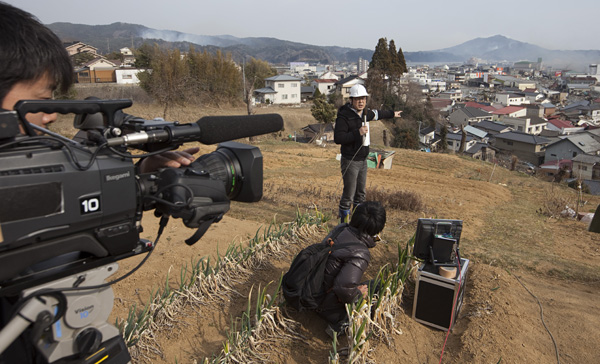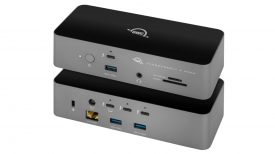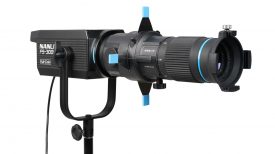Comment by Dan Chung
I did not expect or intend this particular video to trigger the debate that followed on Vimeo and elsewhere in the blogosphere. It feels strangely beside the point to be continuing it when what matters is that 10,000 people have died and many more are missing due to the earthquake and tsunami. But, given the reaction, I feel I should explain why I made it.
The whole piece is honestly the closest I could bring you to what it felt like standing in that place. It’s one thing I’ve found hardest to do in video and to judge from some of the comments, perhaps I have not succeeded. I am not seeking to manipulate the viewer or to tell them how to feel – I am trying to convey how it feels to be there. Yes, it is uncomfortable looking at the ruins of people’s lives. If a disaster doesn’t make you feel uncomfortable then you are not human.
It was not frantic – it had a strange sense of calm. When faced with a scene of devastation like this, as I have been many times, you feel dazed, like you are not really there. It feels like it’s all a bad dream. Watching the survivors I think a lot of them feel the same – it’s shock. I felt the use of camera movement with a slider conveyed this sense of displacement.
Some of the commenters seem to think I am using news as an opportunity to make art. It is the opposite. I have been covering news for a long time and it frustrates me that people do not respond to it. I am trying to use cinematic techniques to make people connect to and care about news, not using news as an opportunity to make cinematic pieces.

There is nothing about a standard news package that is “real” or “authentic” or “unstylised”. It has its own conventions. What worries me is that I think there is often a disconnect from what is ‘on the news’ because it is presented in a pre-packaged way. People are used to it and know what to expect. They stop responding. Just because something IS real, doesn’t mean it ‘feels’ real to the viewer.
TV news rarely gives you a real sense of being in a place as cinema can. Because cinema has a language easily understood by audiences, they do not have to learn a new or alien visual language as they do with other multimedia. The difference is that while cinema uses these techniques to make you suspend disbelief and take you to another world – I am trying to take you to a place in the real world.
There is still plenty of room for ‘straight’ TV style news reports, but there is also room for something else. In text journalism you have stories full of facts and analysis, but you also have colour pieces. There are some excellent pieces of ‘traditional’ multimedia from photojournalists like myself – combining stills, audio and often music – but all the evidence I have seen suggests they do not reach a mass audience.
People have asked why we didn’t speak to locals. We did: it was in the news piece. This is a different piece. My colleague Jon had the option to narrate. We both thought it was better with the music.
(The Guardian decided to re-edit my video into the piece below – adding the voices of some of the survivors. Some commenters preferred it to my original. For me the piece didn’t work at all, mainly because it failed to convey what it felt like to be there.)
Photojournalism tells a story without words; who ordained that news video has to follow a prescribed format? ‘Straight’ TV news is not even a format that has always been around – back in the days of Pathe and Movietone newsreels people would watch a sequence of images with music without objection. That changed in large part because the technology changed. As the technology changes again, news should and will evolve too.
Some have suggested it was inappropriate to set up a small slider and a DSLR in the middle of a disaster zone, but it is surely no more disrespectful or intrusive than the large Japanese news crews and four-person BBC teams present. Nor is it more artificial than a photojournalist shooting stills in black and white, when the world is in colour – something few people question.

As for the music – again, it’s an attempt to convey what it feels like in those places. I guess it is partly a matter of taste but I strongly feel it was the right choice. I’d also add that it’s much more common to use music in Asia, where I live, and perhaps it seems more natural to me than others elsewhere. I often use all natural sound or dialogue when I think it works better. Take a look at my recent Arizona shootings video below.
Below is one of my earlier attempts to convey the feel of a place using cinematic journalism. This was the day the Olympic Bird’s Nest stadium was unveiled to the press. (Back in 2008, shot on a regular camcorder)
People will not like everything I do – some people may not like anything I do – and considered criticism has helped me improve my work. I am grateful to those who have spoken up for me, some of whom did not like this piece but respected my intentions. I feel there has been a valuable discussion around this video and despite some of the negative responses to it I still believe cinematic journalism is a way to involve audiences in world affairs more.
About Dan Chung:
Dan is a Guardian photographer and videographer. He also runs www.dslrnewsshooter.com





